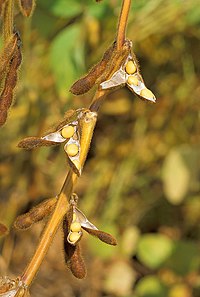
Photo from wikipedia
BACKGROUND Tofu is rich in nutrients and contains high-quality protein. However, commercial tofu products usually have weak gel strength and low water holding capacity. In this study, effects of selective… Click to show full abstract
BACKGROUND Tofu is rich in nutrients and contains high-quality protein. However, commercial tofu products usually have weak gel strength and low water holding capacity. In this study, effects of selective thermal denaturation (STD) time (0-20 min, 5 min interval, 85°C) and glycosylation (100°C, 0, 10 and 20 g kg-1 glucose) on the quality characteristics of green soybean tofu were studied through by the evaluation method of TOPSIS model for the best synergism condition of STD and glycosylation. RESULTS Compared with STD or glycosylation, combination treatment of STD and glycosylation improved hardness, water holding capacity (WHC), yield, protein and fat contents of green soybean tofu. Furthermore, the gel strength, WHC, yield, protein and fat contents of tofu was increased by 135.21%, 20.18%, 12.21%, 24.91%, 44.15% compared with untreated tofu. Meanwhile, synergistic treatment of STD and glycosylation significantly improved microstructure network structure of green soybean tofu and made it more homogeneous and denser. However, the green soybean tofu was faded and turned yellow under the combination of the STD and glycosylation. CONCLUSION The results through TOPSIS showed that the combination of thermal treatment (85°C for 15 min) and glycosylation (20 g kg-1 glucose at 100°C) had the greatest improvement on the characteristics of green soybean tofu. Hence, the combination treatment of STD and glycosylation should be useful to improve the quality characteristics of green soybean tofu and to provide the technical references for industrial processing of tofu. This article is protected by copyright. All rights reserved.
Journal Title: Journal of the science of food and agriculture
Year Published: 2022
Link to full text (if available)
Share on Social Media: Sign Up to like & get
recommendations!